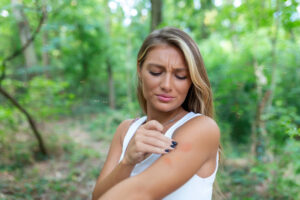Quick REview of Bee STing Allergies
Statistics on Prevalence and Severity
Explanation of Bee Sting Allergic Reaction
When someone has a bee sting allergy and they’re stung, their immune system reacts to the venom like it’s a harmful substance. This triggers an allergic reaction in the body that can be mild or moderate to severe, resulting in anaphylaxis.
It’s normal to have some type of mild reaction to a bee sting that includes: a sharp or burning pain at the sting site, skin discoloration at the site, swelling of the area, and itchiness. However, you should be wary of more severe allergic reaction symptoms such as: hives, difficulty breathing, swelling of the tongue and/or throat, lightheadedness or dizziness, stomach cramps, nausea, diarrhea, and fast pulse.4
If you experience any of these symptoms, call 911 or visit an emergency room immediately because of possible anaphylaxis. Being prepared for these symptoms and the possible need for medical attention is an important reason to create an action plan.

Essential Components of a Bee Sting Allergy Action Plan
Immediate Actions to Take After a Bee Sting
The Cleveland Clinic recommends the following steps immediately after being stung by a bee:
- Remove the stinger carefully and as quickly as possible
- Clean the area with soap and water
- Use an ice pack on the area to reduce swelling
- Monitor the sting for any further allergic reaction
- Take an antihistamine or pain medication to reduce mild symptoms
Action Steps to Include for an Allergic Reaction
Although the initial steps to take after being stung are simple, an action plan should be in place for those who are prone to an allergic response and should be given to all relevant parties, including schools and workplaces.
If your child is allergic to bee or wasp stings, many schools offer a pre-written emergency action plan for your child to be turned into the school nurse. These action plans include basic information like your child’s name and birthday, what allergies they have, what medication should be given depending on symptoms, and emergency contact information. If the school doesn’t have a pre-made action plan available, you should create one using the same necessary information.
Typically, the first step to a severe reaction in this allergy action plan is the use of an epinephrine pen. The steps needed to safely use epinephrine during an emergency should be highlighted in the emergency action plan and family, friends, coworkers, teachers, and school nurses should be trained on how to safely use epinephrine in the case of an emergency.

Action Steps to Include for an Allergic Reaction
Educating the people around you or your loved one is crucial when it comes to managing a potentially life-threatening bee or wasp sting allergy. Educating the people around you can improve the outcomes during an allergic reaction, so it’s vital to share your emergency action plan and instruct them how to safely manage a potential reaction. Training for family, friends, and caregivers is also available, including this training course provided by the American Red Cross.
Regular Review and Practice
Your emergency action plan should be reviewed regularly by you and your healthcare provider. This is to ensure that the plan remains effective and up-to-date with any changes in your condition or treatment options.5
You should also regularly practice your emergency action plan to familiarize yourself and others with the steps needed during an allergic reaction to reduce panic and improve response times.5
Having a comprehensive bee sting allergy action plan helps manage potentially life-threatening reactions to a stinging insect allergy. By understanding the nature of the allergic reaction, recognizing the symptoms, knowing the essential parts of the action plan, educating those around you, and reviewing and practicing the plan, you can feel more comfortable in your daily life. Remember to always consult your medical provider to personalize your action plan so that you or your loved one can remain well-prepared regardless of the situation. You can also find an allergist today using our find a provider service.
- Boyle, R., & Ludman, S. (2015). Stinging insect allergy: Current perspectives on venom immunotherapy. Journal of Asthma and Allergy, 75-86. doi:10.2147/jaa.s62288
- nadolpho. “Insect Sting Allergies | Symptoms & Treatment.” ACAAI Public Website, acaai.org/allergies/allergic-conditions/insect-sting-allergies/.
- Saretta, Francseca, et al. “Venom Immunotherapy Protocols in the Pediatric Population:
- How to Choose?” Frontiers in Pediatrics, 7 Sept. 2023, www.frontiersin.org/articles/10.3389/fped.2023.1192081/full. Accessed 21 May 2024.
- “How Do I Treat a Bee Sting?” Cleveland Clinic, my.clevelandclinic.org/health/diseases/25093-bee-sting.
- “Five Reasons Why Food Allergy Action Plans Are Important – Arizona Asthma and Allergy Institute.” Azsneeze.com, azsneeze.com/fivereasonswhyfoodallergyactionplansareimportant/.






